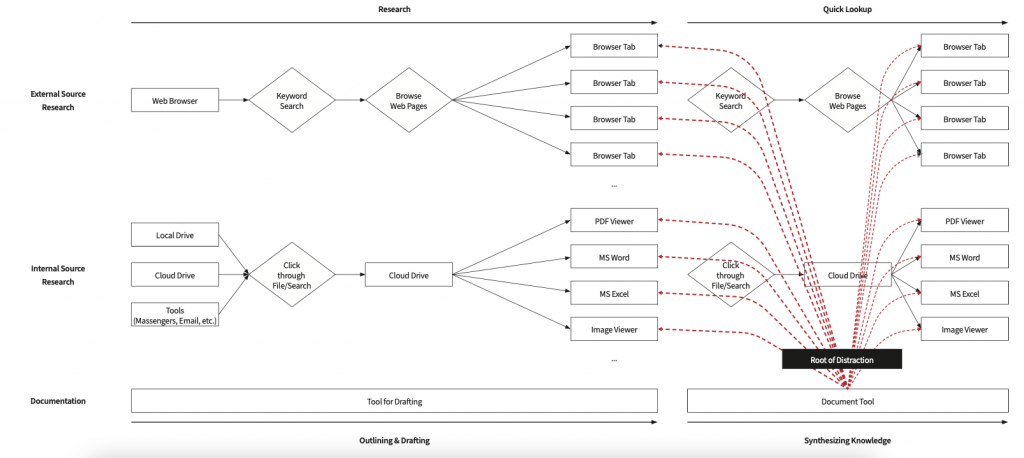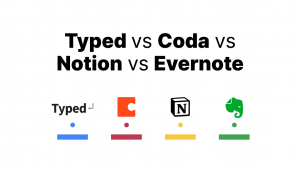There are various types of writing, but Typed aims to focus on creating the most effective and efficient experience for writing research-heavy documents. In the process of writing these documents, knowledge works collect and use resources from both internal and external sources and the problems mentioned above prevail inevitably.
Let’s take a quick look of our general process of research-heavy documents, through the diagram below.

The entire process is divided into two main sections, research and knowledge synthesis. All the resources obtained through different channels during the research process are synthesized together in the actual writing process.
It is undeniable that the amount of accessible information is more than enough to produce top-notch work. The average person processes around 74GB of information daily, how much more for research-driven knowledge workers. However, time is a factor that has to be taken into consideration. A day is only 24 hours and the average person only spends 1⁄3 of the day working. There is not enough time to go through every file, cloud storage, and web page to find the information needed. The process of synthesizing knowledge through writing should always focus on quality and effectiveness, but during the process of research and resource collection, efficiency is key. Typed’s philosophy on how knowledge workers of the digital age should engage the process of document work is as follows:
- Efficiently find, collect, and filter resources with reliable and crucial information
- Effectively write by synthesizing a set of filtered resources with full focus
Too Many Tabs, Too Many Apps ➔ Fully Focus with Split Viewer
During the research stage of writing, having countless numbers of tabs on the browser and opened applications scattered all over the screen is a common experience today.
Most of the resources collected during the research process have different formats within different channels – web browsers, cloud drives, local drives, work tools, etc. Thus it is inevitable that a large number of (browser) tabs and applications remain as a remnant of research.
This becomes a problem during the transition from research stage to knowl- edge synthesis stage. In order to utilize the information collected through writing, the user has to search through the endless number of tabs and apps. This waste of time energy makes it difficult for knowledge workers to immerse themselves in the synthesis of knowledge.
Typed provides a solution that enables the user to fully focus on the synthe- sis of knowledge through writing through a split view interface. Resources collected within Typed can be viewed through a Split Viewer simultaneous- ly while writing, without having to use a separate viewer application. Typed’s Split Viewer currently supports pdf, doc, ppt, and excel formats, as well as web URLs, and will continue to support more formats, including image files. The Split Viewer enables the user to make seamless transitions between resourc- es, filter collected resources, and ultimately utilize the resources to produce high quality writing without having to leave the main workspace.
This is possible because Typed understands the difference between “current document” and “reference material” from the user’s perspective. In most note-taking tools, when a reference material, file or URL, is attached and opened, a separate viewer is opened or the main page is converted to the resource page. The act of leaving the page increases the chances of the user being distracted and losing focus. The use of resources is crucial, but nothing is more important than the document being written and its context. Typed’s workspace with a split viewer interface is a simple, but effective approach that allows the knowledge worker to transition through numerous resources while staying fully focused on the current document’s context.

Distracted Journey ➔ Streamlined Documentation Process
Being overwhelmed with the amount of information being taken in during the research stage even before writing the actual document is a common situa- tion knowledge workers experience. This leads to longer periods of time spent on preparing to write rather than writing itself. In fact, rather than unnecessary visual or cognitive disturbances caused by so many tabs and applications, the biggest burden on paperwork comes from psychological barriers.
The amount of information accessible leads to difficulty of filtering neces- sary information from unnecessary information, causing the user to think that everything is important. This leads the research to become an endless unproductive web surfing and despite spending hours on work, the actual document is left as a blank white paper with only a few sentences. In many cases (whether in school or business), given that paperwork tends to have deadlines, these inefficiencies amplify psychological anxiety and lead to even greater inefficiencies.
Typed is an optimized tool for effective output-driven documents. Knowledge workers are able to create the same quality output in less time, and even end up writing better with increased efficiency. Typed is designed and built around a clear philosophy on how knowledge workers should engage in the process of research and synthesis of knowledge for effective and efficient documentation.

1) Fast collection of resources
Documents with clear goals would have a designated topic and a high-level table of contents. In this type of document, research is aimed at creating a more detailed structure and further filling out the details. In other words, in the pre-research stage to build and flesh out the structure, it is important for users to quickly find and filter good resources while staying focused on the context and the ultimate goal of the document.
Typed’s Browser Extension and Library reflect this philosophy. When collecting resources through the Web Extension, users can quickly collect them in the Inbox of Typed without worrying about further resource organization at this stage(Of course, you can also specify specific documents and folders when the context for the current research is clear.). This is the first filtration process of necessary and unnecessary resources, which is done quickly and efficiently.
2) Deciding how to use resources: Inbox Zero
The valuable resources collected in Typed’s Inbox then can be utilized to its full extent in each document through Typed’s Inbox Zero philosophy. Pri- or to the actual writing process, Typed encourages the user to organize the resources they collected in the research stage in each document-specific re- source library. This is the second filtration and organization process. Through this process, users can filter out unnecessary resources once more and leave only essential information needed. The flexibility of the library allows users to strategically organize the filtered resources based on their personal style of writing. At the end of this stage, the inbox should be empty and necessary resources should all be ready for use. The first filtration process focuses on efficient resource collection, while the second filtration focuses on effective organization.

3) Immersing yourself in the synthesis of knowledge: Minimal Distraction for Search
yped provides a workspace with minimal distraction once the user is ready to write after resources are collected, filtered, and organized. Typed focuses on providing features and interface that allows the user to access further needed resources and information without having to switch to other screens or appli- cations, which could lead to digression or inefficiency.
Typed’s Backlink feature is based on this philosophy, naturally exposing users to previously written documents that reference specific resources collected in the current library. The interface allows users to not only view the backlink documents, but the resource libraries of those documents as well, minimizing the time and effort needed to search for relevant resources.
Furthermore, Typed’s integrated search allows users to search resources from tools that users have access rights to, without ever leaving Typed. It will pro- vide an experience that allows users to immerse themselves in writing per se as much as possible. In addition, various shortcuts will also provide a mouse- less experience that enables users to perform necessary tasks such as re- source reference and search without taking their hands off the keyboard while working on documents.
Scattered Resources & Deliverables ➔ Single Source of Truth

Most document work is not a one-time work, but is often continuous with a certain time frame. New documents often do not deviate significantly from the field or context of the existing document as well. This is especially true for knowledge workers in a particular field of work, or graduate students who work deeply in one area. This means that the current documents and its re- sources will become a valuable resource for the future.
The Typed revolution lies in the difference in the way Typed views documents and resources. Documents are not simply words on paper, but it is an inte- gration of the entire workflow, from research to writing, and all the resources used in between. Since Typed truly understands document work, the collec- tive act of knowledge synthesis, it provides a unique interface consisting of the Library Panel, Split Viewer, and more.
Furthermore, Typed encompasses all of this from a long-term perspective of ‘knowledge management’ beyond documentation, and understands that documents today will become valuable resources in the future. This is not only applicable to individual users, but teams and enterprises as well. Typed is a true second brain that gets stronger as Typers write.
Continue Reading – Graphs and Networks: Human Intelligence Over Human-like Intelligence
Originally Written on Typed’s White Paper by Andy Kim



